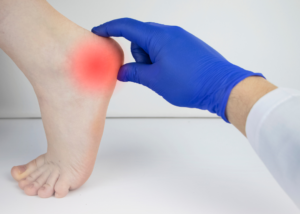Homeschooling during a pandemic. There are no words that can truly explain the experience that we Melbourne parents have had to juggle over the last seven months, especially when it has been only one part of the picture of what life has looked like.
While October 12th is much anticipated, there is one thing in particular that is likely to have changed from when our kids came home in March and now that they’re heading back: their school shoes. So today, we’re showing you how to check your child’s shoe fit at home, why it’s important, and tips for buying new shoes if you need to.
School shoes: Time to check the sizes
An Australian survey of over 2,000 parents selected at random wanted to know whether the shoes their children were wearing were too big, too small, or just right. The results were more surprising than we’d expected:
- 18% of children were wearing shoes TWO sizes too small
- 47% of children were wearing shoe ONE size too small
- 24% of children were wearing the right size shoe, with no room for growth
- 11% were wearing the right size shoe with some room for growth
Really, we can’t be too shocked – kids grow at the speed of light – just ask our two little boys! Some parents report only getting months out of their child’s new shoes, especially in those early years. So it’s time to hit that cupboard and grab those shoes to do your home check. Here are the top things you should look for, thanks to Start-Rite shoes:
The heel fit
While your child is sitting on a chair, put the shoe on and fasten them completely and properly, whether that’s doing up the laces, velcro or other fastening mechanism. Holding their ankle/lower leg in one hand, and the heel of their shoe with another, give the shoe a gentle tug – it should stay firmly in place.
The top fit
With your child standing and the fastening done correctly, move your finger around the top of the shoe where it encloses the ankle. You don’t want there to be any gaps, but you also don’t want it to feel too tight to the point that it may rub. Make sure the ankle bones are sitting above the top of the shoe to stop them rubbing.
The forefoot width
With your child standing, first, examine the shoe, and then rub your fingers around both the inside and outside of the shoe. You should not see or feel any bumps or areas of pressure that are caused by the toes or the bones of the feet. The widest part of the foot should be at the widest part of the shoe.
The shoe depth
Rub your thumb across the top of the shoe. You should feel the fabric move slightly as your thumb moves across it – if it can’t, the shoe may not be deep enough. If you can push the leather material into a ridge, it is too wide.
If the shoe is low cut, move your finger across the front ridge and make sure it doesn’t feel too tight, and that the gap isn’t too wide, either.
The length
Using your thumb at the front of the shoe, check for your child’s longest toe. Remember, this isn’t always their big toe! It’s often their second. Getting your child to wiggle their toes can help. Make sure that the longest toe isn’t right at the very end of the shoe, and you have about a fingers-width available at the end of the shoe. Always check both shoes individually, as one foot is often slightly bigger than the other.
Check the fastening mechanism
Velcro – if your child’s shoes have velcro, you want to check that it’s still working well, so it doesn’t loosen and fail to properly support the shoe throughout the day. You also want to make sure that the velcro contact surface isn’t too small that it’s going to easily come off during the day.
Buckle – for shoes with buckles, you should have at least one buckle to move into either side of the hole you are using.
Lace-ups – you should have about a centimetre gap between the eyelet faces.
Visual check
Finally, have a look at your child walking around in their shoes. Does the heel slip out? Does their ankle feel unstable? Make sure it looks good to you, and ask them about anything you notice.
Time for new shoes?
If your self-check has revealed that it is very much time for new school shoes, then check for these features in the next pair:
1. They’re lightweight – pick up each shoe and have a feel of how much they weigh – and get your kids to the same! If they’re feeling a bit heavy, remember that each foot is going to have to lift this weight up with every step your kids take, which is a lot while running and playing!
2. They have the right amount of flexibility – each shoe is an extension of the foot and its natural movement. Kids tend to have flexible feet, and the shoes should support this movement – not restrict it. The lighter and more flexible, the better! With this said, there are times where we do recommend a firmer shoe. When we’re trying to control the foot because of pain or injury, then it may be best to choose a shoe with a firmer heel counter and less flexibility.
3. It has a fastening mechanism, not slip-ons – compared to slip-ons, shoes with a fastening mechanism such as velcro or laces provide far greater stability and support for kids feet. The more supportive and stable the shoe, the more control over the movement of the foot and ankle within the shoe to reduce the likelihood of injuries such as ankle sprains, as well as facilitate the healthy development of the bones, joints and muscles.
4. It has a removable, supportive liner – shoes that are designed with removable liners are done so with the various needs of children in mind. They may need orthotics, they may need extra cushioning, they may need an in-shoe solution to help with pain. Companies that recognise this need and go out of their way to create it, usually have a better grasp on the good elements of shoes that we’ve discussed too.
5. That they’re the right fit! Using the tips we’ve provided above.
Don’t forget to always take your child with you to get their shoes, bring the socks that they usually wear to school, and to get their shoes towards the end of the day when feet are at their biggest due to swelling.
And if any pains and niggles start in the first week back of school?
Remember, pain never happens for no reason – it’s our body’s way of telling us that something is wrong or isn’t working quite so well. If returning to school sees your child develop new pains and niggles – or old problems come back, bring them in to see our experienced podiatry team. We’re parents too! We’ll help your child get out of pain – and keep them out of pain for the years and adventures to come.
Book your appointment online here or call us on 1300-FX-FEET





